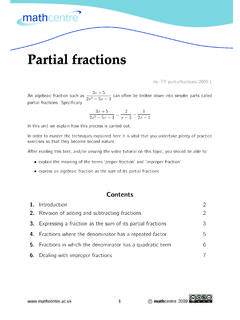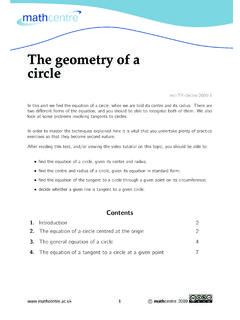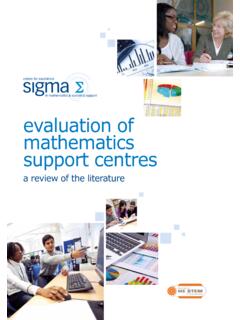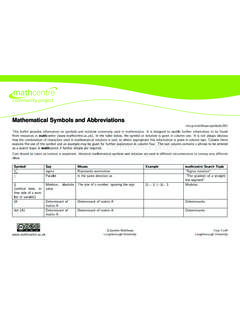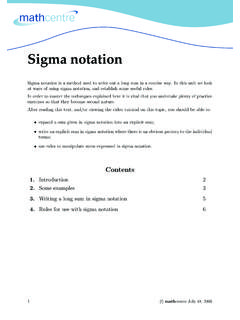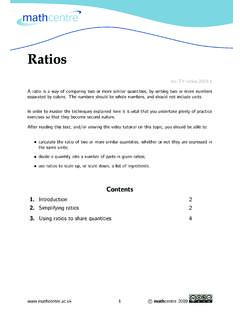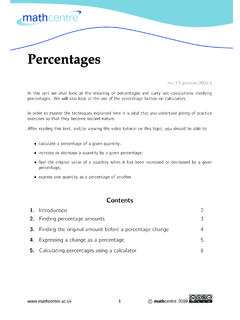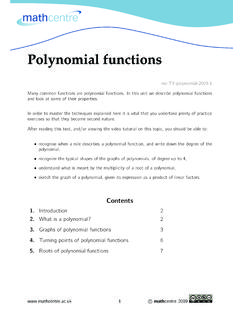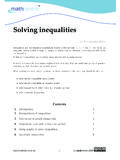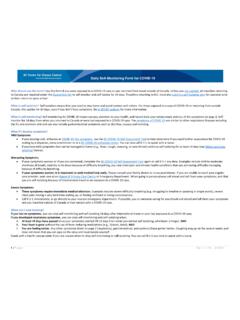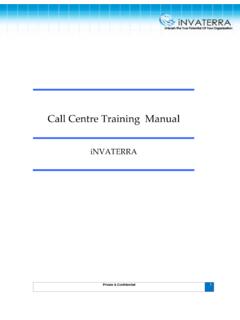Transcription of Logarithms - mathcentre.ac.uk
1 Logarithmsmc-TY- Logarithms -2009-1 Logarithms appear in all sorts of calculations in engineering and science, business and the days of calculators they were used to assist in theprocess of multiplication by replacingthe operation of multiplication by addition. Similarly, they enabled the operation of division tobe replaced by subtraction. They remain important in other ways, one of which is that theyprovide the underlying theory of the logarithm function. This has applications in many fields, forexample, the decibel scale in order to master the techniques explained here it is vital that you do plenty of practice exercisesso that they become second reading this text and / or viewing the video tutorial onthis topic you should be able to: explain what is meant by a logarithm state and use the laws of Logarithms solve simple equations requiring the use of do we study Logarithms ?
2 Is a logarithm ?ifx=anthenlogax= first law of logarithmslogaxy= logax+ second law of logarithmslogaxm= third law of logarithmslogaxy= logax logarithm of 1loga1 = bases 10 and Logarithms to solve mathcentre 20091. IntroductionIn this unit we are going to be looking at Logarithms . However, before we can deal with logarithmswe need to revise indices. This is because Logarithms and indices are closely related, and in orderto understand Logarithms a good knowledge of indices is know that16 = 24 Here, the number 4 is thepower. Sometimes we call it anexponent. Sometimes we call it anindex. In the expression24, the number 2 is called know that64 = this example 2 is the power, or exponent, or index.
3 The number 8 is the Why do we study Logarithms ?In order to motivate our study of Logarithms , consider the following:we know that16 = 24. We also know that8 = 23 Suppose that we wanted to multiply 16 by way is to carry out the multiplication directly using long-multiplication and obtain this could be long and tedious if the numbers were larger than 8 and 16. Can we do thiscalculation another way using the powers ? Note that16 8can be written24 23 This equals27using the rules of indices which tell us to add the powers4and3to give the new power, 7. Whatwas a multiplication sum has been reduced to an addition if we wanted to divide 16 by 8:16 8can be written24 23 This equals21or simply2using the rules of indices which tell us to subtract the powers4and3to give the new power, we had a look-up table containing powers of 2, it would be straightforward to look up27andobtain27= 128as the result of finding16 that by using the powers, we have changed a multiplication problem into one involvingaddition (the addition of the powers, 4 and 3).
4 Historically, this observation led John Napier(1550-1617) and Henry Briggs (1561-1630) to developlogarithmsas a way of replacing multi-plication with addition, and also division with mathcentre 20093. What is a logarithm ?Consider the expression16 = 24. Remember that 2 is the base, and 4 is the power. An alternative,yet equivalent, way of writing this expression islog216 = 4. This is stated as log to base 2 of 16equals 4 . We see that the logarithm is the same as the power orindex in the original is the base in the original expression which becomes the base of the two statements16 = 24log216 = 4are equivalent statements.
5 If we write either of them, we areautomatically implying the we write down that64 = 82then the equivalent statement using Logarithms islog864 = we write down thatlog327 = 3then the equivalent statement using powers is33= the two sets of statements, one involving powers and one involving Logarithms are the general case we have:Key Pointifx=anthen equivalentlylogax=nLet us develop this a little = 101we can write the equivalent logarithmic formlog1010 = , the logarithmic form of the statement21= 2islog22 = general, for any basea,a=a1and sologaa= Pointlogaa= mathcentre 2009We can see from the Examples above that indices and Logarithms are very closely related.
6 Inthe same way that we have rules or laws of indices, we havelaws of Logarithms . These aredeveloped in the following Exercises1. Write the following using Logarithms instead of powersa)82= 64b)35= 243c)210= 1024d)53= 125e)106= 1000000f)10 3= )3 2=19h)60= 1i)5 1=15j) 49 = 7k)272/3= 9l)32 2/5=142. Determine the value of the following logarithmsa)log39b)log232c)log5125d)log1 010000e)log464f)log255g)log82h)log813i)l og3(127)j)log71k)log8(18)l)log48m)logaa5 n)logc co)logssp)loge(1e3)5. The first law of logarithmsSupposex=anandy=amthen the equivalent logarithmic forms arelogax=nandlogay=m(1)Using the first rule of indicesxy=an am=an+mNow the logarithmic form of the statementxy=an+mislogaxy=n+m.
7 Butn= logaxandm= logayfrom (1) and so putting these results together we havelogaxy= logax+ logaySo, if we want to multiply two numbers together and find the logarithm of the result, we can dothis by adding together the Logarithms of the two numbers. This is thefirst Pointlogaxy= logax+ mathcentre 20096. The second law of logarithmsSupposex=an, or equivalentlylogax=n. Suppose we raise both sides ofx=anto the powerm:xm= (an)mUsing the rules of indices we can write this asxm=anmThinking of the quantityxmas a single term, the logarithmic form islogaxm=nm=mlogaxThis is thesecond law. It states that when finding the logarithm of a power of a number, thiscan be evaluated by multiplying the logarithm of the number by that Pointlogaxm=mlogax7.
8 The third law of logarithmsAs before, supposex=anandy=amwith equivalent logarithmic formslogax=nandlogay=m(2)Considerx am=an musing the rules of logarithmic formlogaxy=n mwhich from (2) can be writtenlogaxy= logax logayThis is thethird mathcentre 2009 Key Pointlogaxy= logax logay8. The logarithm of 1 Recall that any number raised to the power zero is 1:a0= 1. The logarithmic form of this isloga1 = 0 Key Pointloga1 = 0 The logarithm of 1 in any base is ExamplesExampleSuppose we wish to is the same as being asked what is 512 expressed as a power of 2 ? Now512is in fact29and solog2512 = we wish to is the same as being asked what is164expressed as a power of 8 ?
9 Now164can be written64 1. Noting also that82= 64it follows that164= 64 1= (82) 1= 8 2using the rules of indices. Solog8164= mathcentre 2009 ExampleSuppose we wish to is the same as being asked what is 25 expressed as a powerof 5 ? Now52= 25and solog525 = we wish to is the same as being asked what is 5 expressed as a power of 25 ? We know that5is a square root of25, that is5 = 25. So2512= 5and solog255 = from the last two examples that by interchanging the base and the numberlog255 =1log525 This is true more generally:Key Pointlogba=1logabTo illustrate this again, consider the following We are asking what is 8 expressed as a power of 2 ?
10 We know that8 = 23and solog28 = aboutlog82? Now we are asking what is 2 expressed as a power of 8 ? Now23= 8and so2 =3 8or81/3. Solog82 = see againlog82 = mathcentre 200910. Exercises3 Each of the following expressions can be simplified the value ofNin each case. We have not explicitly written down the base. Youcan assume the base is 10, but the results are identical whichever base is )log 3 + log 5b)log 16 log 2c)3 log 4d)2 log 3 3 log 2e)log 236 + log 1f)log 236 log 1g)5 log 2 + 2 log 5h)log 128 7 log 2i)log 2 + log 3 + log 4j)log 12 2 log 2 + log 3k)5 log 2 + 4 log 3 3 log 4l)log 10 + 2 log 3 log 211.
